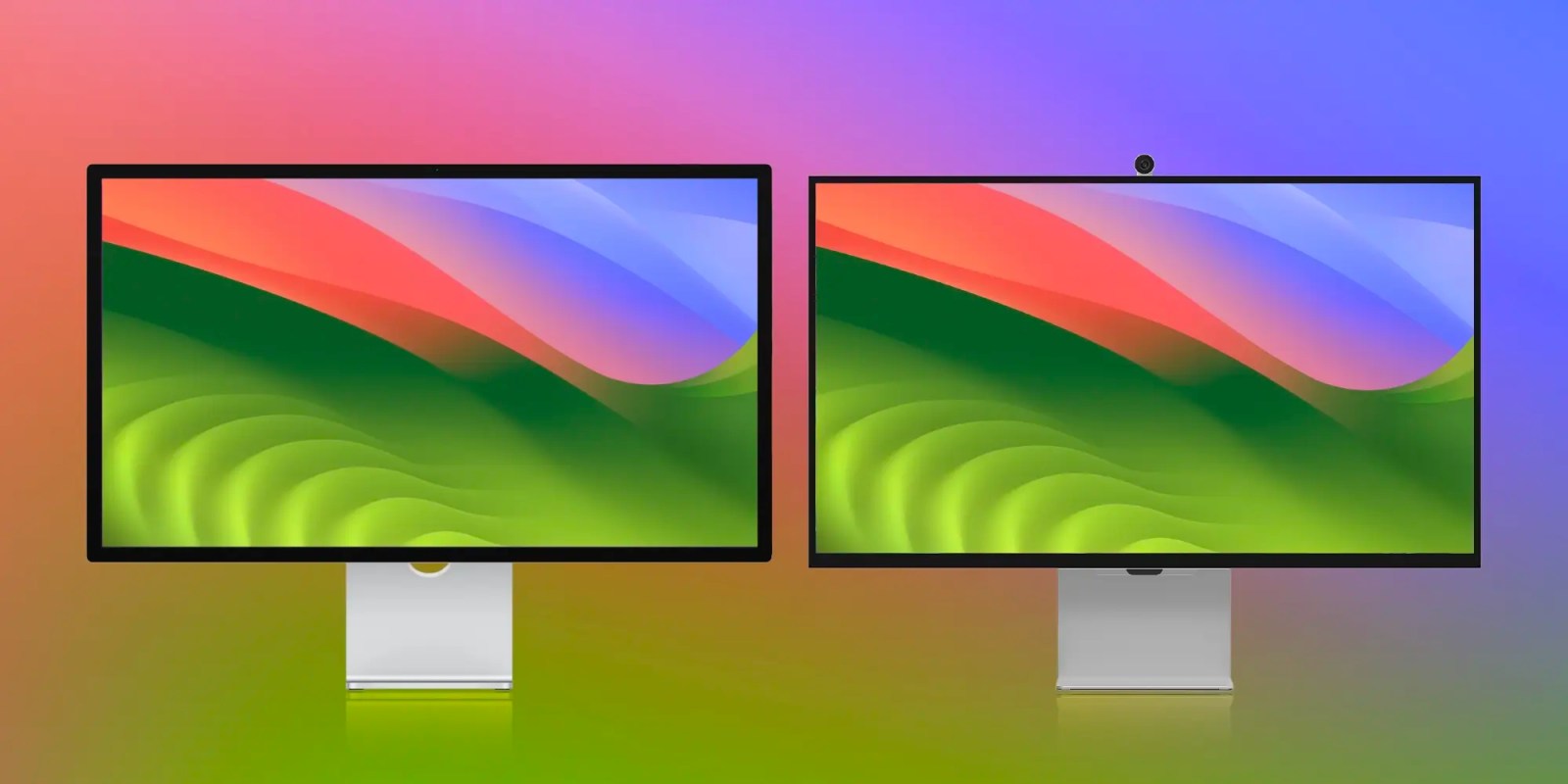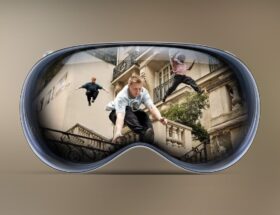
A year and a half after Apple released its Studio Display, Samsung released a direct competitor – the ViewFinity S9 5K monitor. With many of the same features as Studio Display and a few others, it's an interesting alternative. Keep an eye on the ratio of Studio Display and Samsung ViewFinity S9.
Table of Contents
- Reference Information li>
- Apple Studio Display and Samsung ViewFinity S9
- Price
- Display panels
- Connectivity
- Camera and sound
- Design
- Reference modes
- Review of Apple Studio Display and Samsung ViewFinity S9
Background
After support for the Apple Thunderbolt Display was dropped in 2016, the LG UltraFine 27-inch 5K (full review) 21.5-inch display became the Apple-approved display. -inch 4K – later replaced by a 24-inch 4K model.
They checked a number of boxes, such as single Thunderbolt cable connectivity, 4 and 5K resolutions, P3 wide color, and more. But many didn't like the plastic design of LG's UltraFine displays with massive bezels (especially the 27-inch version) and overall design that doesn't meet Apple standards.
In late 2019, Apple started making its own display again with the release of the Pro Display XDR to much excitement. But the price of over $5,000 limits its use to professional use and those who are not price-sensitive.
The Apple Studio Display was released in March 2022 with an impressive list of features and a beautiful aluminum body. in the style of the Pro Display XDR – at a price that more users, creators and businesses can afford.
But it was only a matter of time before competitors like Samsung came along before they released a monitor with similar key features and design – Enter ViewFinity S9 5K monitor.
For reference, we've also included the LG UltraFine 5K in the charts below.
Apple Studio Display vs Samsung ViewFinity S9
Price
Apple Studio Display starts at $1,599 and goes up to $2,299 depending on upgrades. The Samsung ViewFinity S9 costs $1,599 and comes with a number of features that Apple charges extra for.
| Studio Display | Samsung ViewFinity S9 | LG UltraFine 5K | |
| Price | USD 1599–2299 | $1599 | $1299 |
Starting at a difference of $300, you get a lot more for your money with both the Apple Studio Display and the Samsung ViewFinity S9 compared to the LG UltraFine.
Display panels
The panels of these three monitors are almost identical. Both the Studio Display and ViewFinity S9 have brightness up to 600 nits, and the LG UltraFine is just below 500 nits.
Otherwise, you're looking at 27-inch LCD panels with a 5120 x 2880 5K resolution. .
| Studio display | Samsung ViewFinity S9 | LG UltraFine 5K | |
| Size | 27 inches | 27 inches | 27 inches |
| Panel type | LCD display with IPS | IPS LCD | IPS LCD |
| Resolution | 5120 x 2880 (5K) | 5120 x 2880 (5K) | 5120 x 2880 (5K) |
| Aspect Ratio | 16:9 | 16 :9 | 16:9 |
| PPI | 218 | 218 | 218 |
| Update frequency | 60 Hz | 60Hz | 60Hz |
| Brightness | 600 nits | 600 nits | 500 nits |
| P3 wide color | ✅ | ✅ | ✅ |
| Done > | Anti-glare/additional nanotexture | Anti-reflective matte coating | Anti-reflective |
Even though the LG UltraFine is quite old, its panel is not far behind the Studio Display and ViewFinity S9.
Connectivity
All of these displays feature Thunderbolt ports for single-cable connectivity and three additional USB-C ports for peripherals. However, Studio Display excels at speeds of up to 10 Gbps for USB-C ports using USB 3.1 Gen 2.
| Studio Display | Samsung ViewFinity S9 | LG UltraFine 5K | |
| Thunderbolt | 1 above | 1 superior | 1 upstream |
| USB-C | x3 (3.1 Gen 2) | x3 (probably 3.0) | x3 (3.0) |
| Power supply | 96 W | 90 W | 94 W |
| VESA compatible | ✅ (decide when purchasing) | ✅ | ✅ |
| AirPlay | ❌ | ✅ | ❌ |
| Smart Hub TV function with remote control | ❌ | ✅ | ❌ |
Samsung no mention what type of USB-C ports the ViewFinity S9 has, so it's probably 5Gbps 3.0 like the LG UltraFine, not 10Gbps like the Studio Display.
However, Samsung has one additional port than the other two monitors – Mini DisplayPort.
Camera and audio
Studio Display is the first hardware Apple has installed a 12MP ultra-wide camera outside of the iPad Pro/Air. This allows for the valuable Center Stage feature for video calls and provides a 122-degree viewing angle.
It's funny that Apple doesn't mention 1080p at all in the Studio Display's specifications; however, at the Peek Performance event it was said that this is the same camera as the iPad Pro, and the specs page does say 1080p.
But despite its 1080p high definition quality, the Studio Display has come in for fair criticism. The Samsung SlimFit 4K camera included with the ViewFinity S9 may be more effective.
| Display Studio | Samsung ViewFinity S9 | LG UltraFine 5K | |
| Built-in webcam | ✅ | ✅ | ✅ |
| Lens characteristics | 12 MP ultra-wide angle, f/2.4 aperture, 122 degree viewing angle, 1080p support | 4K | 1080p |
| Central stage | ✅ | ❌ | ❌ |
| Speakers | 6 -sound system with spatial audio | 2 x 5 W | 2 x 5 W |
| Microphone | 3-microphone array studio quality | Long-range microphone | ✅ |
However, when When it comes to speakers, the Studio Display can benefit from its six-speaker audio system (four force-cancelling woofers and two tweeters) that can produce spatial audio, and an array of three studio-quality Apple microphones.
This is against two 5W speakers in Samsung and LG monitors.
Design
The design and build quality alone are enough for so that many people prefer Apple Studio Display to LG UltraFine.
But now the Samsung ViewFinity S9 has arrived with a similar, sleek design. Tilt, height and swivel adjustments also come standard. For the Studio Display, you'll have to pay an extra $400 to get a height-adjustable stand.
However, Samsung's ViewFinity uses a metal stand and a silver plastic back panel, while Apple uses aluminum for the entire design.
| Studio Display | Samsung ViewFinity S9 | LG UltraFine 5K | |
| Stand included | ✅ (tilt only, incl., $400 for height + tilt stand) | ✅ (adjustable tilt, height and rotation) | ✅ (tilt and height adjustment) |
| Black plastic housing | – | – | ✅ |
| Aluminum construction | ✅ (all aluminum) | ✅ (aluminum stand, plastic back) | ❌ |
| Is Apple polishing cloth included? | ✅ (with version with nanotexture) | ❌ | ❌ |
| Weightwith stand | 13.9 or 16.9 pounds | 16.3 pounds | 18.7 lbs |
Some reviews mention The all-metal design makes the Apple Studio Display feel more durable than the ViewFinity S9.
Reference Modes
Apple Pro Display XDR is great for professionals with 11 different reference modes (plus custom ones). Meanwhile, Studio Display supports 9 of those 11.
Samsung ViewFinity S9 does not support all the same reference modes, but does include support for:
- DCI -P3
- sRBG
- BT.709
- Custom
- Graphics
- Eco
- Entertain
ViewFinity also comes with Smart Calibration color management software. Here are the reference modes available in Apple Studio Display:
| Studio Display | |
| Apple Display (P3–600 nits) | ✅ |
| Pro XDR display (P3-1600 nits) | ❌ |
| HDR video (P3- ST 2084) | ❌ |
| Video HDTV (BT.709) -BT.1886 | ✅ |
| NTSC Video (BT.601 SMPTE-C) | ✅ |
| PAL and SECAM (BT.601 EBU) | ✅ |
| Digital cinema (P3- DCI) | ✅ |
| Digital Cinema (P3-D65) | ✅ |
| Design and Print (P3–D50) | ✅ |
| Photography (P3–D65) | ✅ |
| Web and Internet (sRGB) | ✅ |
Review Apple Studio Display and Samsung ViewFinity S9
Pros of ViewFinity S9
It may seem like there's nothing that can dissuade Apple users from choosing the Studio Display, since both 5K monitors start at $1,599. However, Samsung includes some features that you'll have to pay a little more for with the Apple Studio Display.
First, to get a height- and tilt-adjustable stand with Apple, the price increases to 1,999 dollars.
And if you also want the less reflective nanotextured glass finish, the Apple Studio display costs $2,299—almost 50% more expensive than the Samsung ViewFinity S9.
Samsung's display comes standard with VESA mount support, and the 4K webcam may be better than Apple's 12MP webcam in the Studio Display.
You also get Smart Hub/TV functionality with the ViewFinity S9. All this makes the S9 ViewFinity attractive.
However, although the ViewFinity uses a metal stand, it has a silver plastic back panel.
But especially on sale – currently $899, the Samsung 5K display looks like a great deal.
Studio Display Pros
Studio Display does have some advantages Features I don't like about the ViewFinity S9: Hey Siri support, Spatial Audio/Dolby Atmos support, studio-quality microphones, the ability to glossy or matte screen finish and end-to-end power of 96 W (versus 90 W for ViewFinity).
<р>And of course, the fact that the Studio Display is an official Apple monitor to match a MacBook or desktop Mac might be enough to tip the scales for many. Add to this the fact that Studio Display uses an all-aluminum body, while Samsung uses a hybrid metal and plastic design.
Eric's Best Comment
There are several Samsung reviews on YouTube and I think there will be many more soon. I've been holding off on purchasing the Studio Display to see what the real-world experience with Viewfinity would be like. One YouTube video I watched (unfortunately in German for many) from someone who owns both monitors and did a comparison with examples stated that both monitors have the same low height, so Samsung's adjustable height will raise the monitor higher , but not lower than Studio Display. It's useful for some, but not for others. The reviewer also compared the speakers and cameras, and the Samsung monitors were inferior to the Studio Display. The frosted screen (in Samsung's case, it's an overlay on the monitor glass where it's prone to damage compared to Apple's more expensive technology that puts the frosted glass behind the glass) may or may not be an advantage. If you suffer from screen glare, this will be an advantage over Apple's glossy display, but it will wash out fine details and make Apple's display look sharper and brighter. For photographers who print on paper, a matte display can be an advantage. Another point made in the video above is that the Samsung ports are harder to reach since they are located behind the monitor arm, while the Studio Display ports are easy to access. Finally, Viewfinity's thinness means it comes with an external power supply. It's better to consider individual needs rather than compare features by feature.
View all comments
Additionally, the Apple Studio Display can sometimes be found for under $1,599, making it more attractive.
What do you think of ViewFinity S9 and Apple Studio Display? Is the new monitor distracting from the Studio Display? Share your thoughts in the comments!
Wondering what are the more affordable yet functional 4K monitors? Our guide provides a complete overview of reliable options:
- Best USB-C and Thunderbolt displays for Mac
Thanks for reading our guide to Studio Display vs Samsung ViewFinity S9!










